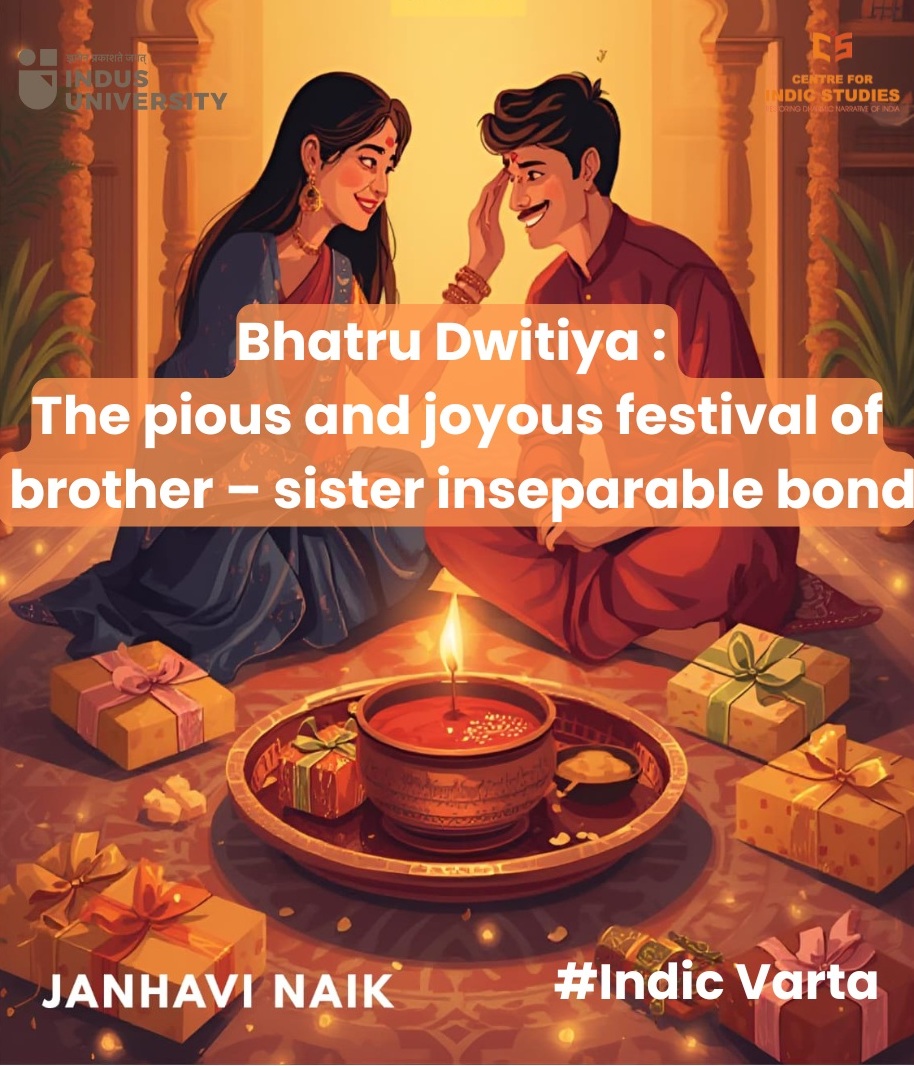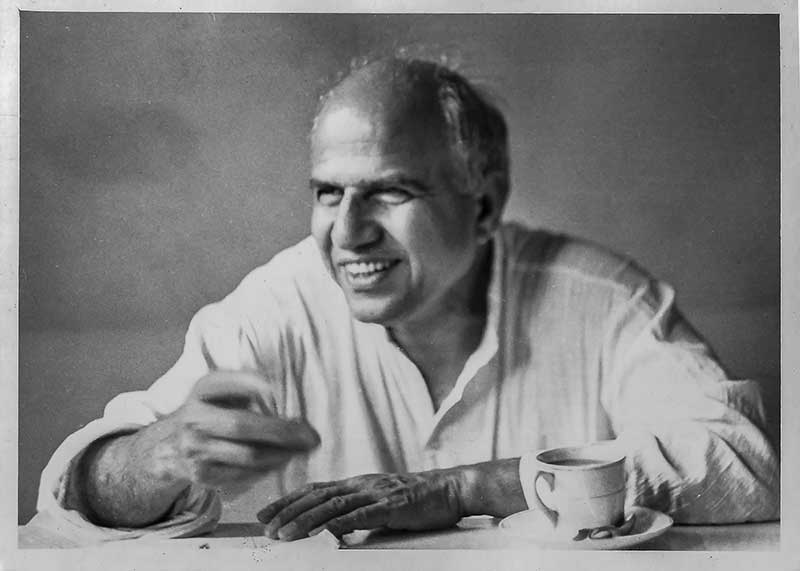- Visitor:27
- Published on: 2025-10-24 06:40 pm
Bhatru Dwitiya : The pious and joyous festival of brother – sister inseparable bond
While a sister offers prayers for her brother’s long and prosperous life, the brother, in turn, bestows his blessings upon her, pledging to safeguard her through every twist of fate. It is a celebration of devotion, trust, and mutual care that transcends the ordinary ties of family. The ritual of Bhai Dooj is not merely ceremonial, but a heartfelt expression of gratitude and protection. In essence, this festival is a luminous reminder of the gentle yet unbreakable thread that binds hearts together across time and distance.

Diyas were lit to brighten the diwali evening, crackers embellished the sky, the sweets that were delighted from tongue to heart were made — and exchanged, rangolis adorned the threshold, beautiful clothes were worn and photos were clicked. That's how we celebrated Deepawali — the biggest festival of Hindu civilization — just a few days ago. But is Diwali a celebration of merely one day? Not at all. It is a series of pious and joyous events.
After worshipping Govardhan Bhagwan, the day after Deepawali, yesterday we celebrated the awaited festival of all sisters and brothers that is Bhatru Dwitiya, popularly known as, Bhai Dooj.
Although, almost all of it, is written on the pious yet sweet – bitter bond of sister and brother but still one can say from its own experience that this bond is indescribable. Every sister — whether younger or elder — is like a mother to their brother, and every brother — whether younger or elder — is like a fatherly hand on the head of their sisters to protect them in the worst situations and cherish them in the beautiful moments. To acknowledge each other's value in their lives, in sanatan culture, we celebrate this festival of Bhai dooj, as sanatan has always valued, embraced and celebrated every nuanced aspect of the entire brahmaand.
The festival of Bhai Dooj (भ्रातृ द्वितीया) is celebrated two days after Diwali, immediately following the Gujarati New Year (Bestu Varsh / બેસતું વર્ષ) or Govardhan Puja. As per the Hindu lunar calendar, this festival falls on the second day (Dwitiya) of the bright fortnight (Shukla Paksha) in the month of Kartika (कार्तिकः शुक्लपक्षे ०२), which usually corresponds to October or November in the Gregorian calendar. The name carries a symbolic meaning — “Bhai” translates to brother, while “Dooj” signifies the second day. Its Sanskrit form, Bhratru Dwitiya (भ्रातृ द्वितीया), conveys the same sense, where “भ्रातृ” means brother and “द्वितीया” means second day.
The Pauranic reference of Bhatru Dwitiya : The adorable and unbreakable bond between Yama and Yamuna
Bhai dooj also known as Yama dwitiya. The pauranic reference of this festival is described in Skanda Purana, Vaishnava Khanda, Kārttikamāsa-māhātmya:
The Mrityunāśaka Yamadwitiya Vrata
(As spoken by Brahmā Deva to Nārada Muni)
Brahmā Deva, says to narada muni:
“O Nārada! Listen attentively, and I shall describe to thee the Mrityunāśaka Yamadwitiya Vrata, the most purifying of vows, destroyer of apamṛtyu, and bestower of long life and prosperity. On the Dwitiya tithi of the bright fortnight of Kārtika, one should rise during the Brahma-muhūrta and contemplate upon the welfare of one’s own self with a serene and pure mind.Having performed śaucha, dantadhāvana, and all acts of purification, one should bathe in the early dawn.
After the bath, let the devotee don śveta vastra (white garments), adorn himself with white flowers, and apply śveta chandan (white sandal paste).Having completed the nitya-karma, and filled with joy, he should proceed to a Udumbara (gūlar) tree. Beneath it, let him prepare a beautiful maṇḍala, and within it draw an aṣṭadala kamala (eight-petalled lotus).
Therein, O Nārada, he shall invoke and worship with single-pointed devotion the deities — Brahmā, Viṣṇu, Śiva, and Vīṇā–pustaka–dhāriṇī Varadāyinī Sarasvatī Devī. Let the worship be performed with chandan, aguru, kastūrī, kuṅkuma, puṣpa, dhūpa, naivedya, and nārikela (coconut). For the removal of untimely death (apamṛtyu-nivāraṇa), he should give to a Veda-vettā Brāhmaṇa a savatṣā gauḥ—a milk-giving cow with her calf—decorated with ornaments and sacred threads.
While offering, he should speak thus: “O revered Vipra! For the cessation of apamṛtyu, I offer unto you this gentle, auspicious, and world-liberating cow, may she ferry me across the ocean of existence.”
If no cow is available, then, O Nārada, the devotee shall offer a pair of sandals (joda jūta) with devotion and humility. Thereafter, having completed the worship, he shall bow to the elders of his household with bhakti and vinaya, keeping his mind absorbed in Bhagavān Viṣṇu Then he shall please his kinsmen with fruits and various delicacies.
Then, O Nārada, the devotee shall go to the home of his elder sister (baṛī bhaginī), salute her devoutly, and say with folded hands: “O auspicious and virtuous sister! Thou art welfare incarnate. For my own well-being, I bow at thy lotus feet.”
Having thus spoken, he should prostrate before her with Bhagavad-bhāvanā (divine devotion). Then the sister, filled with affection, shall address her brother with sweet words, saying: “O brother! By thy presence today I am truly blessed and made auspicious. O light of our lineage, for the increase of thy lifespan, thou must dine at my home today. In ancient times, on this very Kārtika Śukla Dwitiya, the divine Yamunā Devi invited her brother Yama Deva to her abode, served him with great devotion, and offered him food.On that day, Yama Deva released all beings bound by the fetters of karma, allowing them to move freely according to their will. Hence, O brother, even learned men abstain from eating in their own homes on this sacred tithi.”
Hearing her words, the devotee, filled with joy, should worship his sister with vastra and ābharaṇa (garments and ornaments), bow at her feet, and receive her blessings. Then he shall satisfy all his sisters likewise, gifting them ornaments and garments with love. If one has no own sister, he should go to the house of his uncle’s daughter (chāchā kī putrī) or father’s sister, and partake of food there with reverence.
O Nārada! He who performs this Yamadwitiya Vrata in the prescribed manner becomes free from apamṛtyu, blessed with sons and grandsons, and ultimately attains mokṣa
All such vratas and dānas are most befitting for a gṛhastha (householder). He who listens with faith to this sacred Yamadwitiya Kathā is freed from all sins — thus speaks Mādhava Himself.
He who bathes in the Yamunā on the Kārtika Śukla Dwitiya never beholds the abode of Yama.
Those who, on this day, satisfy their soubhāgyavatī sisters with gifts of garments and ornaments remain free from quarrels and fear of enemies for an entire year.
It was on this tithi that Yamunā, moved by sisterly affection, served and fed her brother Yama Deva. Therefore, he who partakes of food offered by his sister on Yamadwitiya attains wealth, prosperity, and auspicious fortune. Even kings, O Nārada, should release prisoners on this day that they may dine in their sisters’ homes.
If one has no sister, he may regard his maternal aunt’s daughter (māma-kī putrī), or any woman of the same gotra, as his sister and honour her accordingly.
If none such exists, he may consider even a cow or a river as his sister; or, in their absence, a forest or thicket and there perform the rite with sincerity.
The Dwitiya tithi on which the brother partakes of food from his sister’s hand is alone auspicious and acceptable; one must not dine in one’s own home on Yamadwitiya, and only the meal taken before noon is considered proper.
Thus, O Nārada, is the observance of the Mrityunāśaka Yamadwitiya Vrata described — the destroyer of untimely death, the bestower of long life, prosperity, and liberation.”
Another pauranic story :
There is another Historical account of Lord Krishna & his sister Subhadra. According to the Puranas, on this day, Lord Krishna visited his sister Subhadra after killing demon Narkasur. His sister Subhadra gave a warm welcome to him by applying a mark (तिलकम्) on Lord Krishna’s forehead, garlanded him & offered different sweets & special dishes. Since that day, the ritual began of worshipping for the wellbeing of brothers by sisters hence this day became famous by the name Bhratru Dwitiya (भ्रातृ द्वितीया).
Bhatru dwitiya : Same affection celebrated under different names in the entire bharat land
Across India, this festival is observed in various names and customs across regions, languages, and traditions:
In Northern India, it is known as Bhai Dooj and is widely celebrated by the Awadhi community in Uttar Pradesh.
In West Bengal, Assam, Tripura, and Bangladesh, it is called Bhai Phonta and is marked by affectionate rituals between brothers and sisters.
In Andhra Pradesh, Telangana, and some parts of Tamil Nadu, it is celebrated as Bhatru Dwitiya or Bhaghini Hastha Bhojanamu.
Among Marathi and Konkani-speaking communities in Maharashtra, Goa, and Karnataka, it is known as Bhau Beej (भाऊबीज) or Bhav Bij. Rituals include applying tilak (तिलकम्) on the forehead, performing aarti (आरार्तिकम्), and preparing dishes like basundi puri or sikarkand puri.
In Gujarat, it is celebrated as Bhai Beej (ભાઈ બીજ), where sisters invite their brothers home and serve sweets and special dishes.
In Haryana, it is called Bhaiya Dooj, where a special ritual involves using a dry coconut tied with a thread during the aarti (आरार्तिकम्).
In Nepal, it is known as Bhai Tika (भाई टीका) and is celebrated with great importance by the Khas community. The highlight of the day is the Saptarangi Tika, a seven-coloured mark applied on the brother’s forehead.
In some southern parts of India, it is referred to as Yama Dwitiya (यम द्वितीया), linked with the divine story of Yama and Yamuna.
In Western Odisha, it is known as Bhai Jiuntia, celebrated not in Kartika but in the month of Ashvina (अश्विनः शुक्लपक्षे ०८) on the eighth day of the bright fortnight, with similar rituals and significance.
The Poojan Vidhi followed on Bhatru dwitiya
On Bhai Dooj, sisters decorate the pooja thali with vermilion, sandalwood, fruits, flowers, sweets, and betel nut. A seat of rice flour is made for the brother, on which he sits while waiting for the rituals. Sisters recite sacred mantras, pour water on their brother’s palms, tie kalava on their wrist, and apply tilak on the forehead.Flowers of kaddu, betel nut, betel leaves, and coins are then offered in the brother’s palms.Afterward, kalava is tied, and the sister performs aarti with a lit lamp facing her brother. Seeing a flying kite in the sky on this day is believed to bring fulfillment of wishes. After the tilak and aarti, the brother gives gifts to his sister and takes a pledge to protect her life.
Thus, this festival embodies the enduring bond of love, faith, and respect between siblings. While a sister offers prayers for her brother’s long and prosperous life, the brother, in turn, bestows his blessings upon her, pledging to safeguard her through every twist of fate. It is a celebration of devotion, trust, and mutual care that transcends the ordinary ties of family. The ritual of Bhai Dooj is not merely ceremonial, but a heartfelt expression of gratitude and protection. In essence, this festival is a luminous reminder of the gentle yet unbreakable thread that binds hearts together across time and distance.
- 13 min read
- 1
- 0










